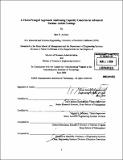| dc.contributor.advisor | Joel Cutcher-Gershenfeld and Daniel E. Whitney. | en_US |
| dc.contributor.author | Awbrey, Bret R. (Bret Robert) | en_US |
| dc.contributor.other | Leaders for Manufacturing Program. | en_US |
| dc.date.accessioned | 2007-04-20T15:52:44Z | |
| dc.date.available | 2007-04-20T15:52:44Z | |
| dc.date.copyright | 2006 | en_US |
| dc.date.issued | 2006 | en_US |
| dc.identifier.uri | http://hdl.handle.net/1721.1/37219 | |
| dc.description | Thesis (M.B.A.)--Massachusetts Institute of Technology, Sloan School of Management; and, (S.M.)--Massachusetts Institute of Technology, Engineering Systems Division; in conjunction with the Leaders for Manufacturing Program at MIT, 2006. | en_US |
| dc.description | Includes bibliographical references (p. 80). | en_US |
| dc.description.abstract | Following the tragedies of 9/11 in the United States and the ensuing down years for the aerospace industry, there are now signs of a comeback. This increase in demand is causing stress on the operations of many aerospace companies, who reduced operations and cut costs during the slowdown. This thesis proposes a three-pronged approach to undertake when looking to increase the capacity of an operation. The first step is to start changing the mindset on the shop floor to value all production pieces. The second step is to utilize all the analytical tools (such as Statistical Process Control) available to reduce set-up time and improve the targeted improvement activities of the operation. The third step is to properly evaluate the costs of purchasing new equipment and comparing that with potential alternative technologies. The proper utilization of these steps requires a thorough understanding of the organization's culture and how these change initiatives impact the relevant stakeholders. Without this organizational understanding, the chance of successfully meeting the increased customer demand is reduced. A case study was performed using this methodology at the Turbine Module Center at Pratt and Whitney. | en_US |
| dc.description.abstract | (cont.) A potential way to change the mindset of the operators on the floor was identified surrounding the qualifying of machines to run a given part. Then, by using a more rigorous SPC program, a significant amount of wasted capacity was identified and the potential gains were mapped out. Then assuming that the implementation of the previous two-steps did not yield enough of an improvement to cover the missed demand, two alternative technologies were evaluated to determine what kind of equipment to purchase. This three-pronged approach will ensure that the organization can meet their expected demand long into the future. | en_US |
| dc.description.statementofresponsibility | by Bret R. Awbrey. | en_US |
| dc.format.extent | 80 p. | en_US |
| dc.language.iso | eng | en_US |
| dc.publisher | Massachusetts Institute of Technology | en_US |
| dc.rights | M.I.T. theses are protected by copyright. They may be viewed from this source for any purpose, but reproduction or distribution in any format is prohibited without written permission. See provided URL for inquiries about permission. | en_US |
| dc.rights.uri | http://dspace.mit.edu/handle/1721.1/7582 | |
| dc.subject | Sloan School of Management. | en_US |
| dc.subject | Engineering Systems Division. | en_US |
| dc.subject | Leaders for Manufacturing Program. | en_US |
| dc.title | A three-pronged approach addressing capacity concerns in advanced turbine airfoil coatings | en_US |
| dc.title.alternative | 3-pronged approach addressing capacity concerns in advanced turbine airfoil coatings | en_US |
| dc.type | Thesis | en_US |
| dc.description.degree | S.M. | en_US |
| dc.description.degree | M.B.A. | en_US |
| dc.contributor.department | Leaders for Manufacturing Program at MIT | en_US |
| dc.contributor.department | Massachusetts Institute of Technology. Engineering Systems Division | |
| dc.contributor.department | Sloan School of Management | |
| dc.identifier.oclc | 85776695 | en_US |
